Deep Learning Approach for Damage Classification Based on Acoustic Emission Data in Composite Materials
Abstract
:1. Introduction
2. Experiment Procedures and Methods
2.1. Material Preparation and Test Procedure
2.2. AE Data Acquisition Device
2.3. Experimental Data and AE Datasets
2.4. InceptionTime Model
2.5. Methodology for InceptionTime Model-Based Damage Classification
3. Results and Discussion
3.1. Train
3.1.1. Raw AE Time Series Data
3.1.2. Frequency-Domain Sequence Data
3.2. Evaluation Metrics
3.3. Comparative Analysis
4. Conclusions
Author Contributions
Funding
Institutional Review Board Statement
Informed Consent Statement
Data Availability Statement
Acknowledgments
Conflicts of Interest
References
- Zhang, Y.; Li, Y.; Zhang, J.; Pan, J.; Zhang, L.; Tan, F.; Wei, H.; Zhang, W. High-Temperature Effect on the Tensile Mechanical Properties of Unidirectional Carbon Fiber-Reinforced Polymer Plates. Materials 2021, 14, 7214. [Google Scholar] [CrossRef]
- Chawla, K.K. Composite Materials; Springer: Cham, Switzerland, 2019; pp. 297–311. [Google Scholar]
- Leone, C.; Lopresto, V.; Papa, I.; Caprino, G. Triangulation method as a valid tool to locate the damage in unidirectional CFRP laminates. Compos. Struct. 2012, 94, 2418–2423. [Google Scholar] [CrossRef]
- Dharmawan, F.S.G.H. Mixed mode fracture toughness of GFRP composites. Compos. Struct. 2006, 75, 328–338. [Google Scholar] [CrossRef]
- Li, W.; Liu, Y.; Jiang, P.; Guo, F.; Cheng, J. Study on Delamination Damage of CFRP Laminates Based on Acoustic Emission and Micro Visualization. Materials 2022, 15, 1483. [Google Scholar] [CrossRef]
- Pereira, A.B.; de Morais, A.B. Mixed mode I+II interlaminar fracture of glass/epoxy multidirectional laminates—Part 2: Experiments. Compos. Sci. Technol. 2006, 66, 1896–1902. [Google Scholar] [CrossRef]
- Xu, D.; Liu, P.F.; Chen, Z.P. A deep learning method for damage prognostics of fiber-reinforced composite laminates using acoustic emission. Eng. Fract. Mech. 2022, 259. [Google Scholar] [CrossRef]
- Torabi, K.; Shariati-Nia, M.; Heidari-Rarani, M. Moving support technique for delaminatoin detection in laminated composite beams using the first natural frequency. J. Reinf. Plast. Comp. 2017, 36, 1116–1128. [Google Scholar] [CrossRef]
- Torabi, K.; Shariati-Nia, M.; Heidari-Rarani, M. Experimental and theoretical investigation on transverse vibration of delaminated cross-ply composite beams. Int. J. Mech. Sci. 2016, 115, 1–11. [Google Scholar] [CrossRef]
- Qin, R.; Zhou, W.; Han, K.; Liu, J.; Ma, L. Near-surface delamination induced local bending failure of laminated composites monitored by acoustic emission and micro-CT. J. Mater. Sci. 2021, 56, 19936–19954. [Google Scholar] [CrossRef]
- Urbaha, M.; Agafonovs, I.; Turko, V.; Fescuks, J. Three Stages of Composite Specimen Destruction in Static Failure. Latv. J. Phys. Tech. Sci. 2021, 58, 61–67. [Google Scholar] [CrossRef]
- Balasubramaniam, K.; Ziaja, D.; Jurek, M.; Fiborek, P.; Malinowski, P. Experimental and Numerical Analysis of Multiple Low-Velocity Impact Damages in a Glass Fibered Composite Structure. Materials 2021, 14, 7268. [Google Scholar] [CrossRef]
- Barile, C. Innovative mechanical characterization of CFRP by using acoustic emission technique. Eng. Fract. Mech. 2019, 210, 414–421. [Google Scholar] [CrossRef]
- Yoon, S.; Chen, D.; Han, S.; Fiborek, P.; Malinowski, P. AE analysis of delamination crack propagation in carbon fiber-reinforced polymer materials. J. Mech. Sci. Technol. 2015, 29, 17–21. [Google Scholar] [CrossRef]
- Liu, S.; Wu, C.; Zhou, J.; Liu, T.; Zhuang, S.; Luo, Y.; Yang, X. Relation between the shear stress distribution and the resulting acoustic emission variation in concrete beams. Struct. Control Hlth. 2020, 27. [Google Scholar] [CrossRef]
- Sikdar, S.; Ostachowicz, W.; Pal, J. Damage-induced acoustic emission source identification in an advanced sandwich composite structure. Compos. Struct. 2018, 202, 860–866. [Google Scholar] [CrossRef]
- Urbahs, A.; Carjova, K. Bolting Elements of Helicopter Fuselage and Tail Boom Joints Using Acoustic Emission Amplitude and Absolute Energy Criterion. J. Aerospace Eng. 2019, 32. [Google Scholar] [CrossRef]
- Jinachandran, S.; Rajan, G. Fibre Bragg Grating Based Acoustic Emission Measurement System for Structural Health Monitoring Applications. Materials 2021, 14, 897. [Google Scholar] [CrossRef]
- Liu, P.F.; Chu, J.K.; Liu, Y.L.; Zheng, J.Y. A study on the failure mechanisms of carbon fiber/epoxy composite laminates using acoustic emission. Mater. Design 2012, 37, 228–235. [Google Scholar] [CrossRef]
- Mouzakis, D.E.; Dimogianopoulos, D.G. Acoustic emission detection of damage induced by simulated environmental conditioning in carbon fiber reinforced composites. Eng. Fract. Mech. 2019, 210, 422–428. [Google Scholar] [CrossRef]
- Lissek, F.; Haeger, A.; Knoblauch, V.; Hloch, S.; Pude, F.; Kaufeld, M. Acoustic emission for interlaminar toughness testing of CFRP: Evaluation of the crack growth due to burst analysis. Compos. Part B Eng. 2018, 136, 55–62. [Google Scholar] [CrossRef]
- Behnia, A.; Ranjbar, N.; Chai, H.K.; Masaeli, M. Failure prediction and reliability analysis of ferrocement composite structures by incorporating machine learning into acoustic emission monitoring technique. Constr. Build. Mater. 2016, 122, 823–832. [Google Scholar] [CrossRef]
- Lacidogna, G.; Piana, G.; Carpinteri, A. Damage monitoring of three-point bending concrete specimens by acoustic emission and resonant frequency analysis. Eng. Fract. Mech. 2019, 210, 203–211. [Google Scholar] [CrossRef]
- Panasiuk, K.; Dudzik, K. Determining the Stages of Deformation and Destruction of Composite Materials in a Static Tensile Test by Acoustic Emission. Materials 2022, 15, 313. [Google Scholar] [CrossRef]
- Oh, H.; Won, J.; Woo, S.; Kim, T. Determination of Impact Damage in CFRP via PVDF Signal Analysis with Support Vector Machine. Materials 2020, 13, 5207. [Google Scholar] [CrossRef]
- Chandarana, N.; Sanchez, D.M.; Soutis, C.; Gresil, M. Early Damage Detection in Composites during Fabrication and Mechanical Testing. Materials 2017, 10, 685. [Google Scholar] [CrossRef]
- Koziol, M.; Figlus, T. Failure Progress of 3D Reinforced GFRP Laminate during Static Bending, Evaluated by Means of Acoustic Emission and Vibrations Analysis. Materials 2015, 8, 8751–8767. [Google Scholar] [CrossRef] [Green Version]
- Guo, Y.; Shang, D.; Zuo, L.; Qu, L.; Hou, G.; Cai, D.; Jin, T.; Yin, X. Identification of fatigue damage modes for carbon fiber/epoxy composites using acoustic emission monitoring under fully reversed loading. Polym. Compos. 2022, 43, 3371–3385. [Google Scholar] [CrossRef]
- Ozaslan, E.; Yetgin, A.; Acar, B.; Guler, M.A. Damage mode identification of open hole composite laminates based on acoustic emission and digital image correlation methods. Compos. Struct. 2021, 274, 114299. [Google Scholar] [CrossRef]
- Liu, Y. Research progress of acoustic emission detection technology based on modal theory. J. Comput. Methods Sci. Eng. 2021, 21, 853–864. [Google Scholar] [CrossRef]
- Xu, B.; Wu, J.; Wang, M. Study of modal acoustic emission to monitor the impact damage in a composite plate. J. Vibroeng. 2017, 19, 3335–3348. [Google Scholar] [CrossRef] [Green Version]
- Liu, H.; Zhang, Y. Image-driven structural steel damage condition assessment method using deep learning algorithm. Measurement 2019, 133, 168–181. [Google Scholar] [CrossRef]
- Kundu, A.; Sikdar, S.; Eaton, M.; Navaratne, R. A Generic Framework for Application of Machine Learning in Acoustic Emission-Based Damage Identification. In Proceedings of the 13th International Conference on Damage Assessment of Structures, Porto, Portugal, 9–10 July 2019; pp. 244–262. [Google Scholar]
- Krizhevsky, A.; Sutskever, I.; Hinton, G.E. Imagenet classification with deep convolutional neural networks. Adv. Neural Inf. Process. Syst. 2012, 25, 1097–1105. [Google Scholar] [CrossRef]
- Ebrahimkhanlou, A.; Schneider, M.B.; Dubuc, B.; Salamone, S. A Deep Learning Framework for Acoustic Emission Sources Localization and Characterization in Complex Aerospace. Mater. Eval. 2021, 79, 391–400. [Google Scholar] [CrossRef]
- Tao, C.; Zhang, C.; Ji, H.; Qiu, J. Fatigue damage characterization for composite laminates using deep learning and laser ultrasonic. Compos. Part B Eng. 2021, 216, 108816. [Google Scholar] [CrossRef]
- Racle, E.; Godin, N.; Reynaud, P.; Fantozzi, G. Fatigue Lifetime of Ceramic Matrix Composites at Intermediate Temperature by Acoustic Emission. Materials 2017, 10, 658. [Google Scholar] [CrossRef] [Green Version]
- Wang, Z.; Dixit, P.; Chegdani, F.; Takabi, B.; Tai, B.L.; El Mansori, M.; Bukkapatnam, S. Bidirectional Gated Recurrent Deep Learning Neural Networks for Smart Acoustic Emission Sensing of Natural Fiber-Reinforced Polymer Composite Machining Process. Smart Sustain. Manuf. Syst. 2020, 4, 179–198. [Google Scholar] [CrossRef]
- Sathiyamurthy, R.; Duraiselvam, M.; Sevvel, P. Acoustic Emission Based Deep Learning Technique to Predict Adhesive Bond Strength of Laser Processed CFRP Composites. FME Trans. 2020, 48, 611–619. [Google Scholar] [CrossRef]
- Bach, P.D.; Kim, J.; Kim, C.; Kim, J. Deep Learning Object-Impulse Detection for Enhancing Leakage Detection of a Boiler Tube Using Acoustic Emission Signal. Appl. Sci. 2019, 9, 4368. [Google Scholar] [CrossRef] [Green Version]
- Louis, S.M.; Nasiri, A.; Bao, J.; Cui, Y.; Zhao, Y.; Jin, J.; Huang, X.; Hu, J. Remaining Useful Strength (RUS) Prediction of SiCf-SiCm Composite Materials Using Deep Learning and Acoustic Emission. Appl. Sci. 2020, 10, 2680. [Google Scholar] [CrossRef]
- Cardarilli, G.C.; Di Nunzio, L.; Fazzolari, R.; Giardino, D.; Matta, M.; Re, M.; Spano, S. Acoustic Emissions Detection and Ranging of Cracks in Metal Tanks Using Deep Learning. In Applications in Electronics Pervading Industry, Environment and Society; Applepies 2019; Springer: Cham, Switzerland, 2020; pp. 325–331. ISBN 978-3-030-37276-7. [Google Scholar]
- Daugela, A.; Chang, C.H.; Peterson, D.W. Deep learning based characterization of nanoindentation induced acoustic events. Mater. Sci. Eng. A 2021, 800, 140273. [Google Scholar] [CrossRef]
- Haile, M.A.; Zhu, E.; Hsu, C.; Bradley, N. Deep machine learning for detection of acoustic wave reflections. Struct. Health Monit. 2020, 19, 1340–1350. [Google Scholar] [CrossRef]
- Sikdar, S.; Liu, D.; Kundu, A. Acoustic emission data based deep learning approach for classification and detection of damage-sources in a composite panel. Compos. Part B Eng. 2022, 228, 109450. [Google Scholar] [CrossRef]
- Ebrahimkhanlou, A.; Salamone, S. Single-sensor acoustic emission source localization in plate-like structures: A deep learning approach. In Health monitoring of Structural and Biological Systems XII; SPIE: Bellingham, DC, USA, 2018. [Google Scholar] [CrossRef]
- Ebrahim, S.A.; Poshtan, J.; Jamali, S.M.; Ebrahim, N.A. Quantitative and Qualitative Analysis of Time-Series Classification Using Deep Learning. IEEE Access 2020, 8, 90202–90215. [Google Scholar] [CrossRef]
- Jiang, W. Time series classification: Nearest neighbor versus deep learning models. SN Appl. Sci. 2020, 2, 721. [Google Scholar] [CrossRef] [Green Version]
- Fawaz, H.I.; Forestier, G.; Weber, J.; Idoumghar, L.; Muller, P. Deep learning for time series classification: A review. Data Min. Knowl. Discov. 2019, 33, 917–963. [Google Scholar] [CrossRef] [Green Version]
- Jin, X.; Yang, A.; Su, T.; Kong, J.; Bai, Y. Multi-Channel Fusion Classification Method Based on Time-Series Data. Sensors 2021, 21, 4391. [Google Scholar] [CrossRef]
- Pengxiang, S.; Wenwen, Y.; Zheng, Q. Self-Supervised Pre-Training for Time Series Classification. In Proceedings of the 2021 International Joint Conference on Neural Networks (IJCNN), Shenzhen, China, 18–22 July 2021; p. 8, ISBN 978-1-6654-3900-8. [Google Scholar]
- Jeon, G.; Bellandi, V.; Chehri, A. Editorial for the Special Issue “Advanced Machine Learning for Time Series Remote Sensing Data Analysis”. Remote Sens. 2020, 12, 2815. [Google Scholar] [CrossRef]
- Dahmene, F.; Yaacoubi, S.; El Mountassir, M.; Bendaoud, N.; Langlois, C.; Bardoux, O. On the modal acoustic emission testing of composite structure. Compos. Struct. 2016, 140, 446–452. [Google Scholar] [CrossRef]
- Martinez-Jequier, J.; Gallego, A.; Suarez, E.; Javier Juanes, F.; Valea, A. Real-time damage mechanisms assessment in CFRP samples via acoustic emission Lamb wave modal analysis. Compos. Part B Eng. 2015, 68, 317–326. [Google Scholar] [CrossRef]
- Yaacoubi, S.; Dahmene, F.; Bouzenad, A.; El Mountassir, M.; Aouini, M. Modal acoustic emission for composite structures health monitoring: Issues to save computing time and algorithmic implementation. Compos. Struct. 2018, 183, 338–346. [Google Scholar] [CrossRef]
- GB/T 3362-2017; Standard Test. Test for Tensile Properties of Carbon Fiber Multifilament. AQSIQ: Beijing, China, 2017.
- Talreja, R.; Singh, C.V. Damage and Failure of Composite Materials; Cambridge University Press: Cambridge, UK, 2012; ISBN 9780521819428. [Google Scholar]
- GB/T 2567-2008; Standard Test. Test Methods for Properties of Resin Casting Body. AQSIQ: Beijing, China, 2008.
- Ghadirdokht, A.; Heidari-Rarani, M. Delamination R-curve behavior of curved composite laminates. Compos. Part B Eng. 2019, 175, 107139. [Google Scholar] [CrossRef]
- ASTM Standard D5528-13; Standard Test. Method for Mode I Interlaminar Fracture Toughness of Unidirectional Fiber-Reinforced Polymer Matrix Composites. ASTM International: West Conshohocken, PA, USA, 2013; p. 13.
- Teimouri, F.; Heidari-Rarani, M.; Aboutalebi, F.H. Finite element modeling of mode I fatigue delamination growth in composites under large-scale fiber bridging. Compos. Struct. 2021, 263, 113716. [Google Scholar] [CrossRef]
- Ismail Fawaz, H.; Lucas, B.; Forestier, G.; Pelletier, C.; Schmidt, D.F.; Weber, J.; Webb, G.I.; Idoumghar, L.; Muller, P.; Petitjean, F. InceptionTime: Finding AlexNet for time series classification. Data Min. Knowl. Disc. 2020, 34, 1936–1962. [Google Scholar] [CrossRef]
- Fawaz, H.I.; Forestier, G.; Weber, J.; Idoumghar, L.; Muller, P. Deep Neural Network Ensembles for Time Series Classification. In Proceedings of the 2019 International Joint Conference on Neural Networks (IJCNN), Budapest, Hungary, 14–19 July 2019. [Google Scholar]
- Liu, F.; Gao, S.; Tian, Z.; Liu, D. A new time-frequency analysis method based on single mode function decomposition for offshore wind turbines. Mar. Struct. 2020, 72, 102782. [Google Scholar] [CrossRef]
- Yang, L.; Shami, A. On hyperparameter optimization of machine learning algorithms: Theory and practice. Neurocomputing 2020, 415, 295–316. [Google Scholar] [CrossRef]
- Probst, P.; Boulesteix, A.; Bischl, B. Tunability: Importance of Hyperparameters of Machine Learning Algorithms. J. Mach. Learn. Res. 2019, 20, 1–39. [Google Scholar]
- DeGroot, P.J.; Wijnen, P.; Janssen, R. Real-time frequency determination of acoustic emission for different fracture mechanisms in carbon epoxy composites. Compos. Sci. Technol. 1995, 55, 405–412. [Google Scholar] [CrossRef]
- Morscher, G.N. Modal acoustic emission of damage accumulation in a woven SiC/SiC composite. Compos. Sci. Technol. 1999, 59, 687–697. [Google Scholar] [CrossRef]
- Muir, C.; Swaminathan, B.; Almansour, A.S.; Sevener, K.; Smith, C.; Presby, M.; Kiser, J.D.; Pollock, T.M.; Daly, S. Damage mechanism identification in composites via machine learning and acoustic emission. Npj Comput. Mater. 2021, 7, 95. [Google Scholar] [CrossRef]
- Ramasso, E.; Butaud, P.; Jeannin, T.; Sarasini, F.; Placet, V.; Godin, N.; Tirillo, J.; Gabrion, X. Learning the representation of raw acoustic emission signals by direct generative modelling and its use in chronology-based clusters identification. Eng. Appl. Artif. Intel. 2020, 90, 103478. [Google Scholar] [CrossRef]
- Yang, Z.; Wei, Y.; Li, J.; Feng, L.; Hou, Z. A novel feature representation method based on original waveforms for acoustic emission signals. Mech. Syst. Signal Process. 2020, 135, 106365. [Google Scholar] [CrossRef]
- Stanley, K.O.; Clune, J.; Lehman, J.; Miikkulainen, R. Designing neural networks through neuroevolution. Nat. Mach. Intell. 2019, 1, 24–35. [Google Scholar] [CrossRef]
- Ojha, V.K.; Abraham, A.; Snasel, V. Metaheuristic design of feedforward neural networks: A review of two decades of research. Eng. Appl. Artif. Intel. 2017, 60, 97–116. [Google Scholar] [CrossRef] [Green Version]
- Deng, X.; Liu, Q.; Deng, Y.; Mahadevan, S. An improved method to construct basic probability assignment based on the confusion matrix for classification problem. Inform. Sci. 2016, 340, 250–261. [Google Scholar] [CrossRef]
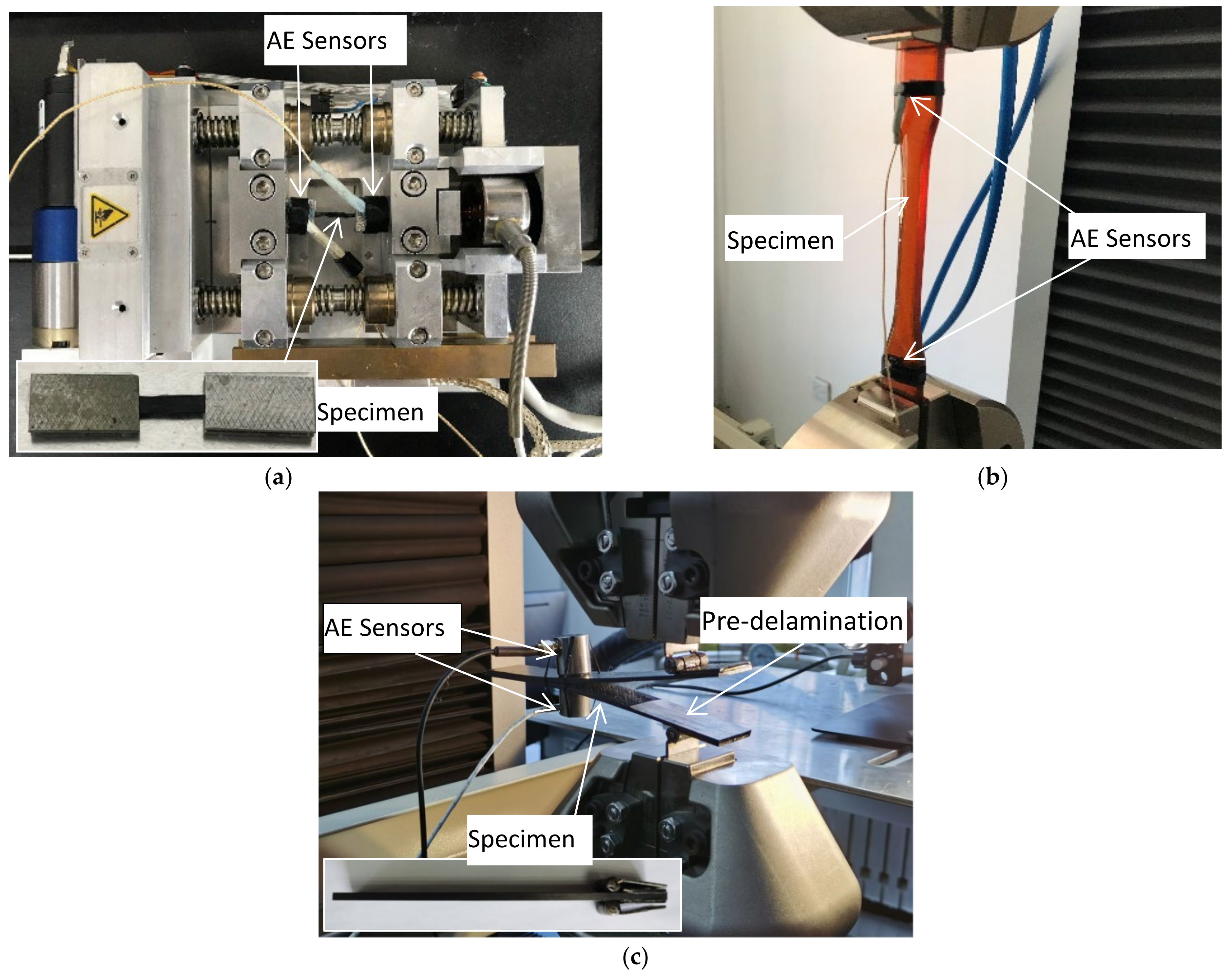
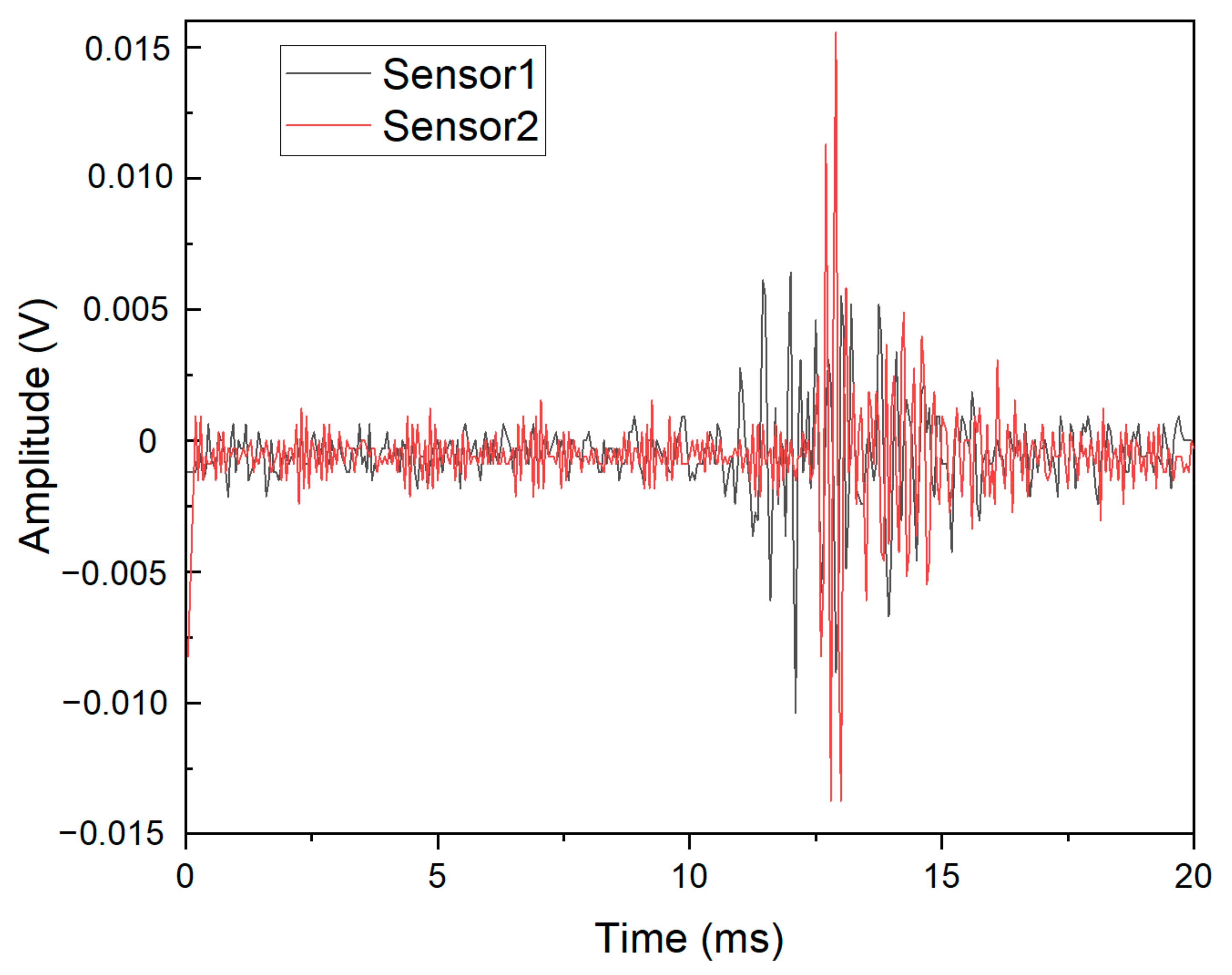


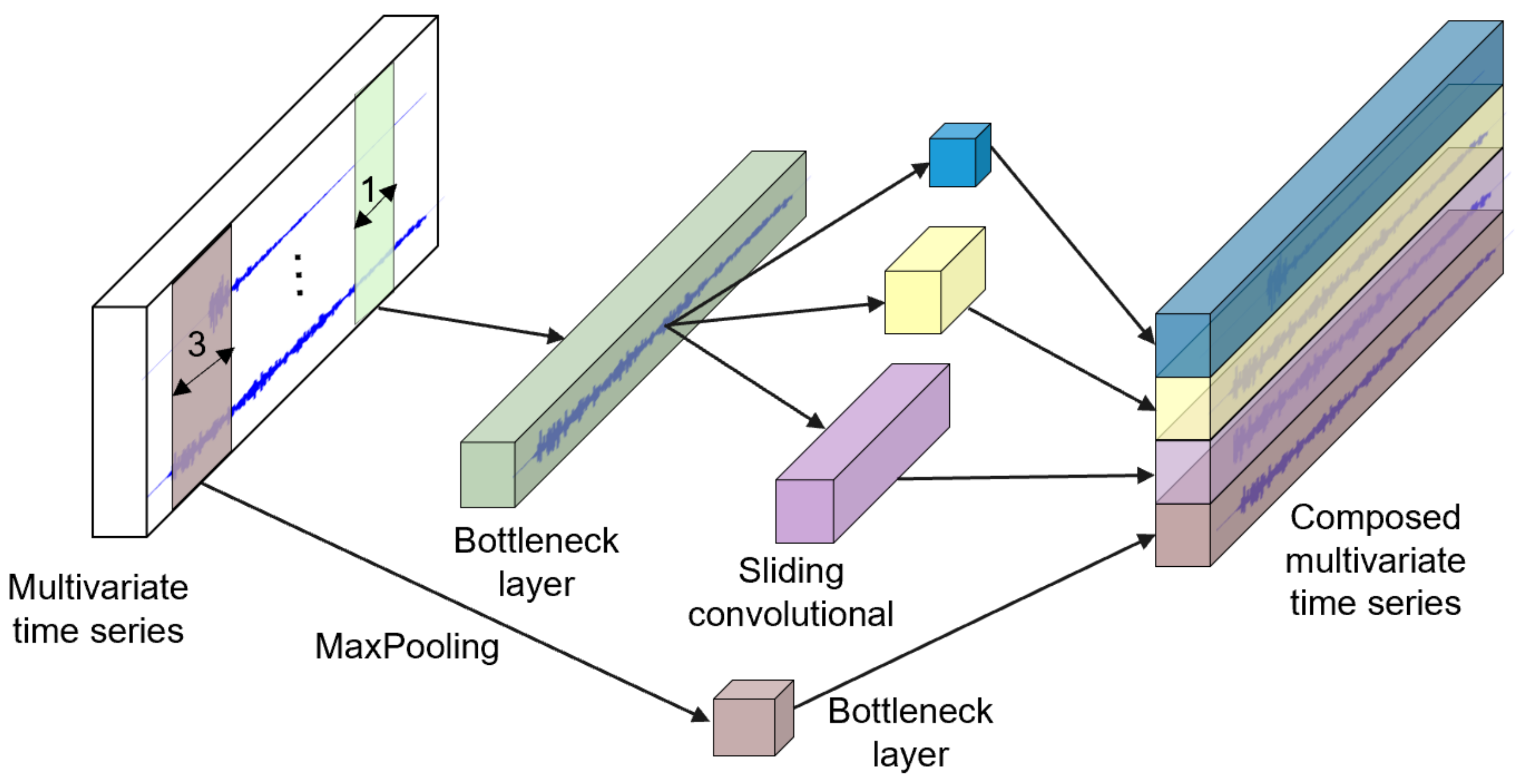

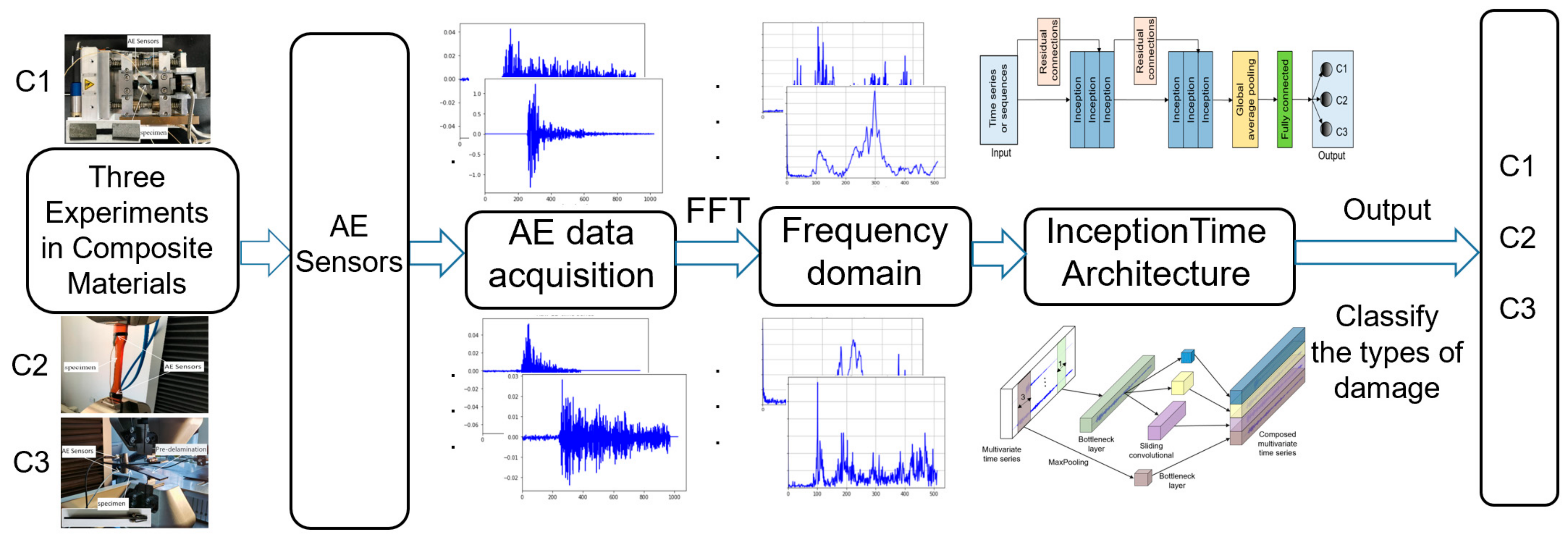

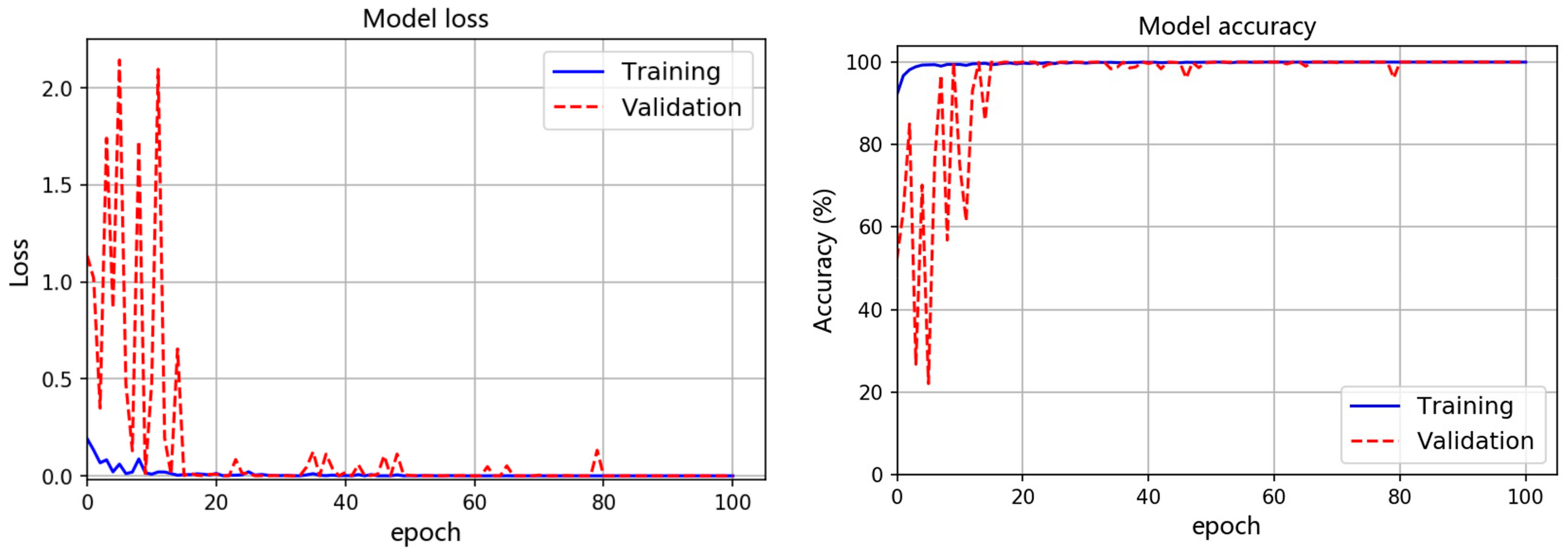
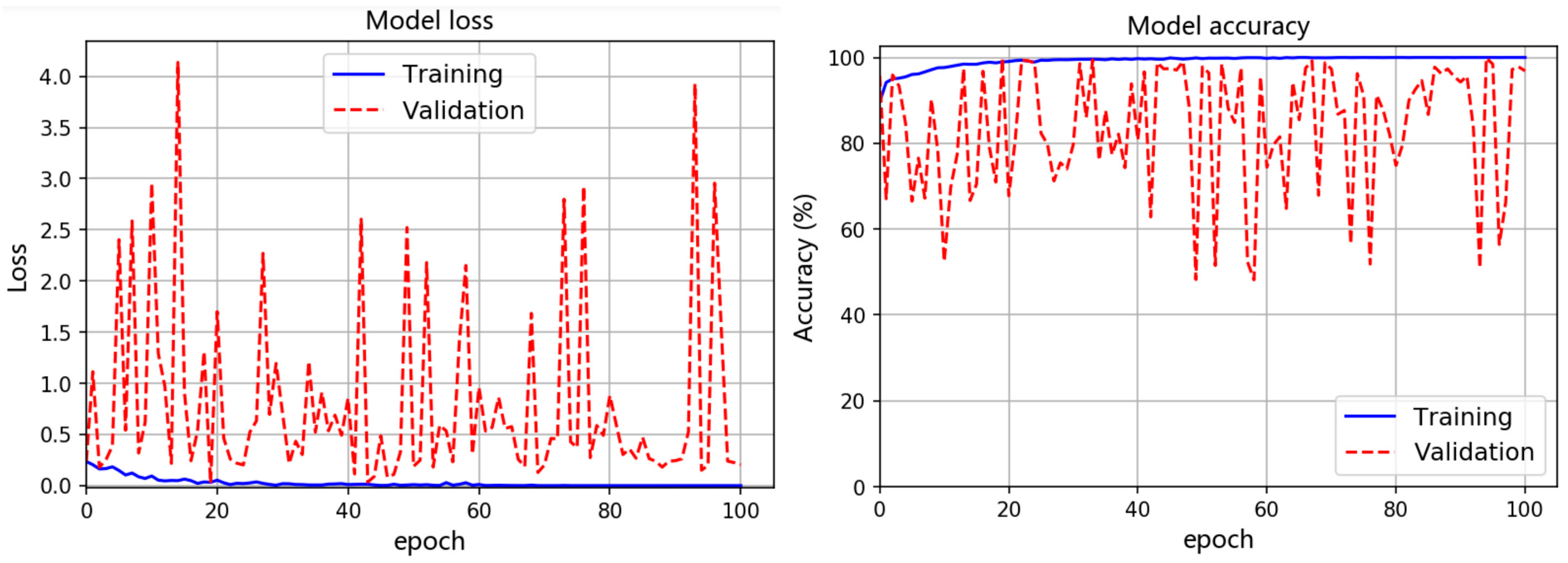
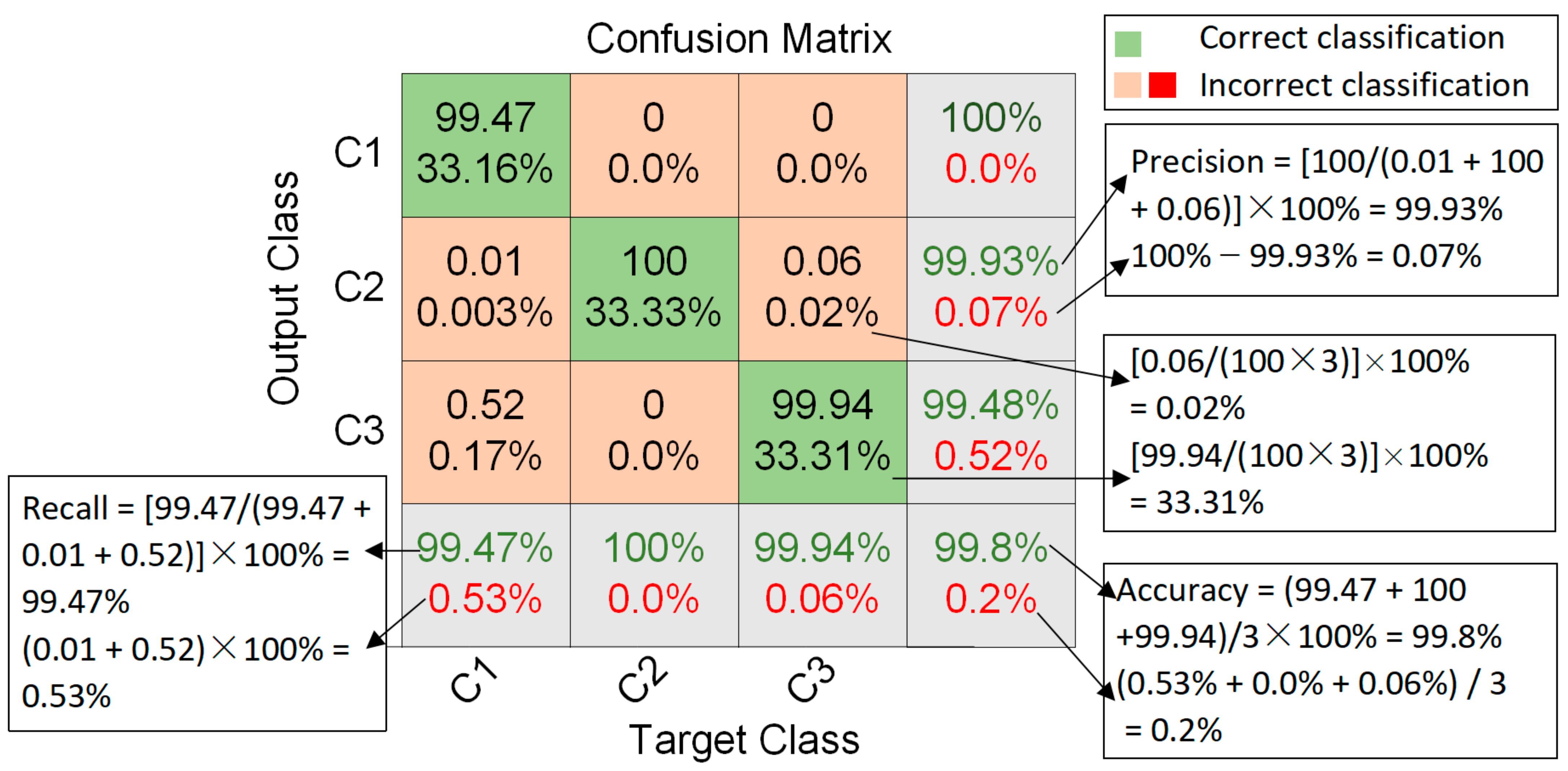
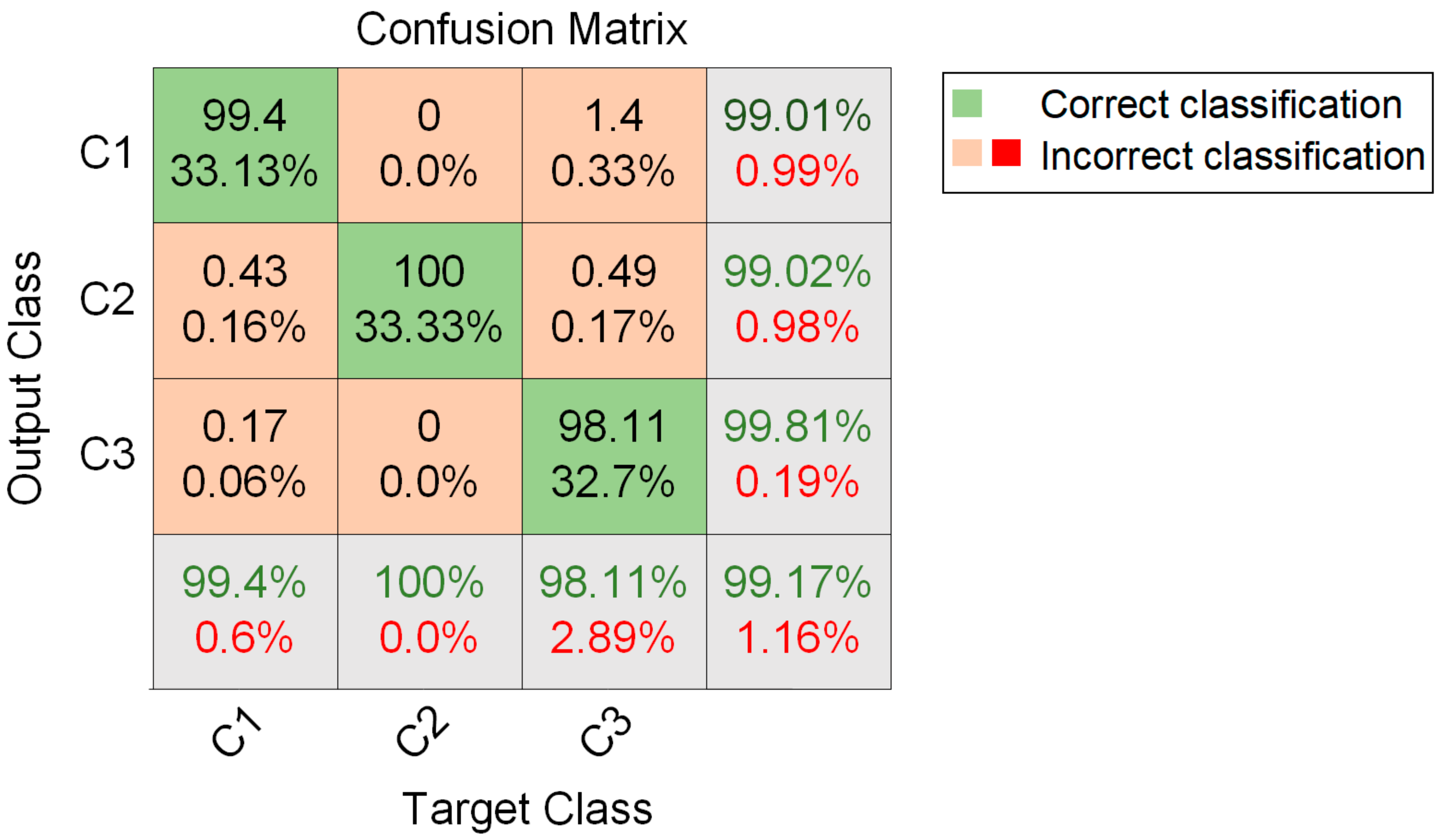
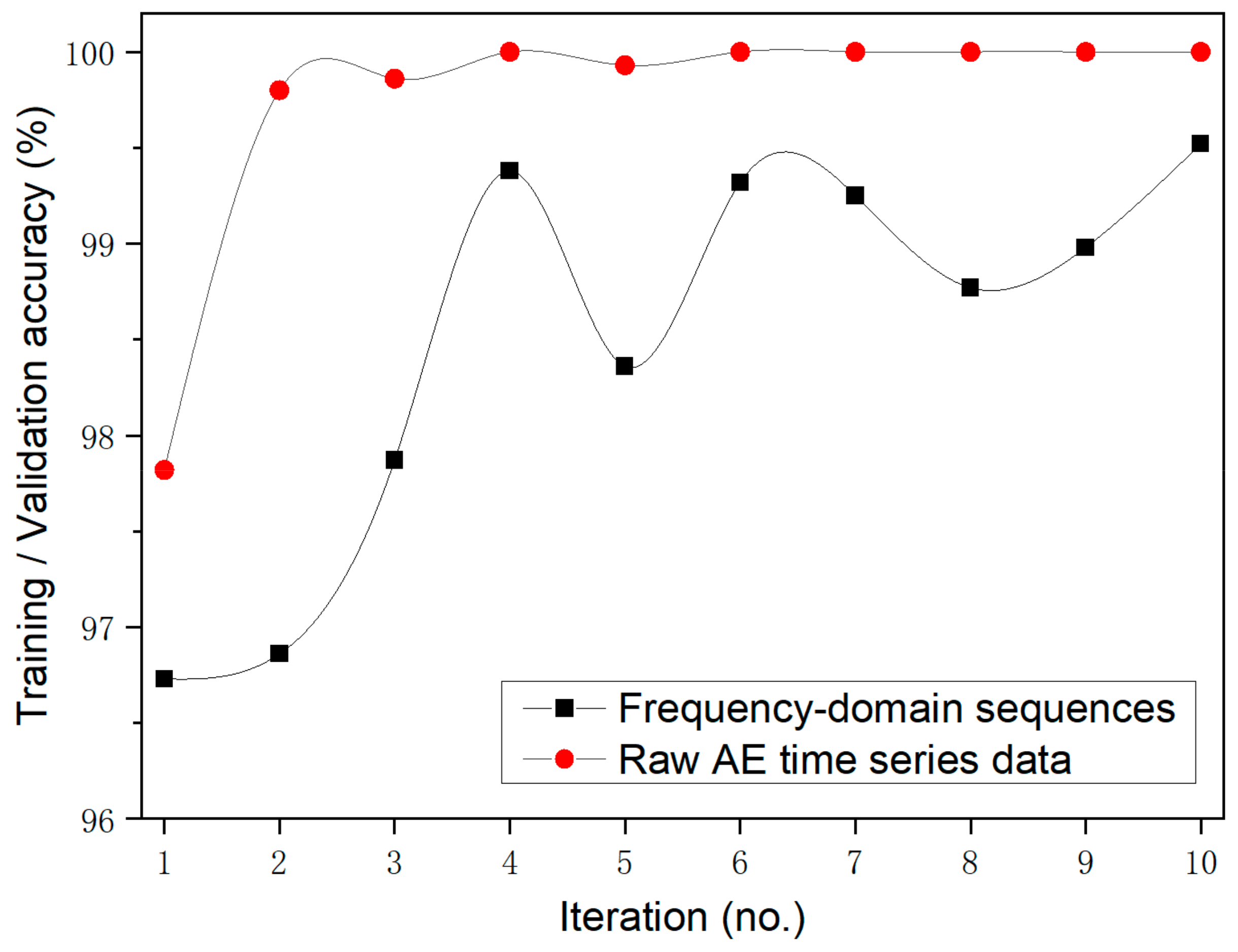

| Parameters | Average Value |
|---|---|
| Tensile strength/GPa | 4.9 |
| Tensile modulus/GPa | 230 |
| Elongation % | 2.10 |
| Density/kg/m3 | 1800 |
| Poisson’s ratio | 0.307 |
| Diameter/μm | 7 |
| Parameters | Average Value |
|---|---|
| Tensile strength/MPa | 75 |
| Tensile modulus/GPa | 3 |
| Elongation % | 0.2 |
| Density/(kg/m3) | 980 |
| Poisson’s ratio | 0.38 |
| Parameter | Setting Value |
|---|---|
| Threshold/dB | 35 |
| Sampling rate/MSPS | 1 |
| Pre-trigger time/μs | 256 |
| Peak definition time (PDT)/μs | 100 |
| Hit definition time (HDT)/μs | 200 |
| Hit locking time (HLT)/μs | 400 |
Publisher’s Note: MDPI stays neutral with regard to jurisdictional claims in published maps and institutional affiliations. |
© 2022 by the authors. Licensee MDPI, Basel, Switzerland. This article is an open access article distributed under the terms and conditions of the Creative Commons Attribution (CC BY) license (https://creativecommons.org/licenses/by/4.0/).
Share and Cite
Guo, F.; Li, W.; Jiang, P.; Chen, F.; Liu, Y. Deep Learning Approach for Damage Classification Based on Acoustic Emission Data in Composite Materials. Materials 2022, 15, 4270. https://doi.org/10.3390/ma15124270
Guo F, Li W, Jiang P, Chen F, Liu Y. Deep Learning Approach for Damage Classification Based on Acoustic Emission Data in Composite Materials. Materials. 2022; 15(12):4270. https://doi.org/10.3390/ma15124270
Chicago/Turabian StyleGuo, Fuping, Wei Li, Peng Jiang, Falin Chen, and Yinghonglin Liu. 2022. "Deep Learning Approach for Damage Classification Based on Acoustic Emission Data in Composite Materials" Materials 15, no. 12: 4270. https://doi.org/10.3390/ma15124270
APA StyleGuo, F., Li, W., Jiang, P., Chen, F., & Liu, Y. (2022). Deep Learning Approach for Damage Classification Based on Acoustic Emission Data in Composite Materials. Materials, 15(12), 4270. https://doi.org/10.3390/ma15124270






